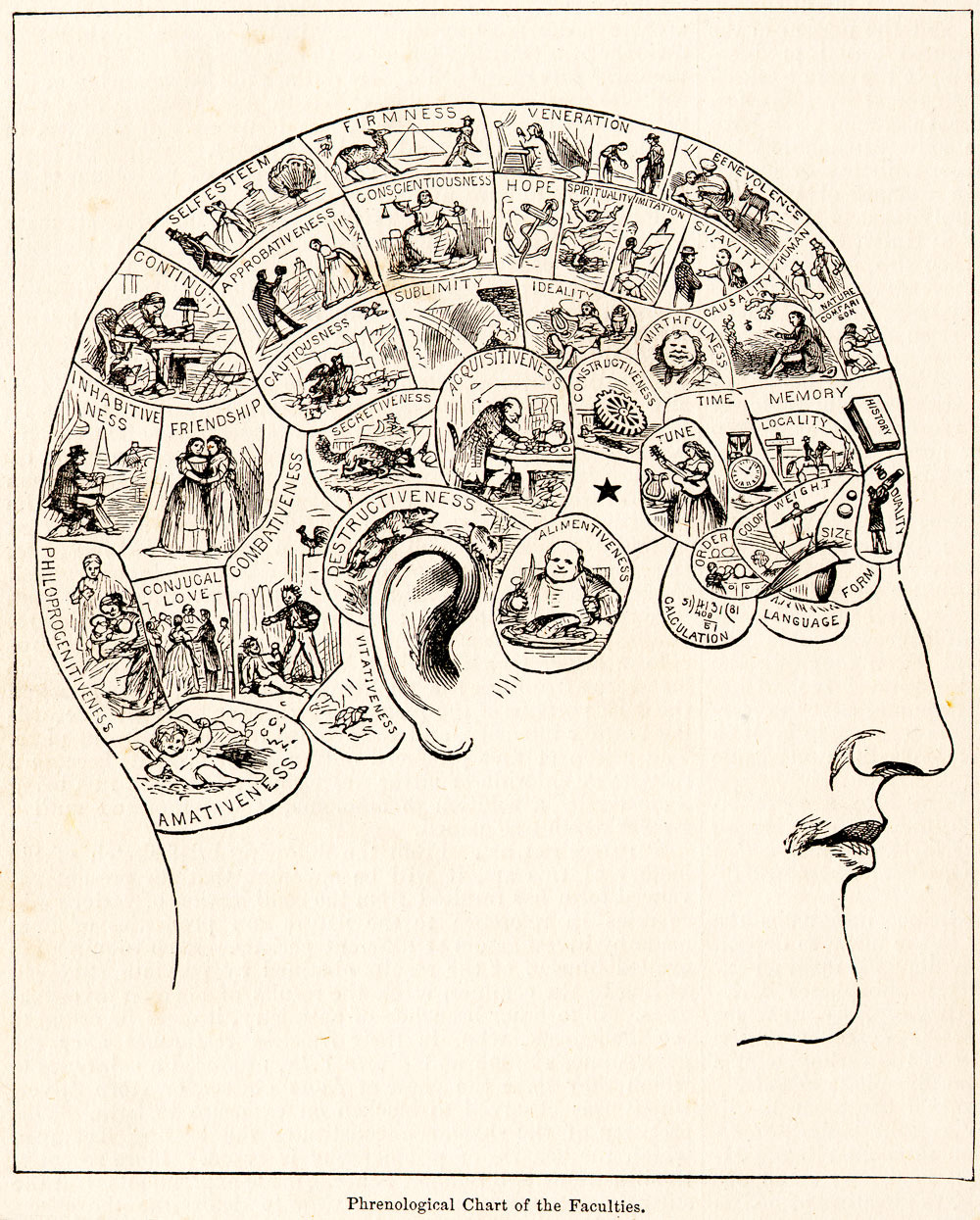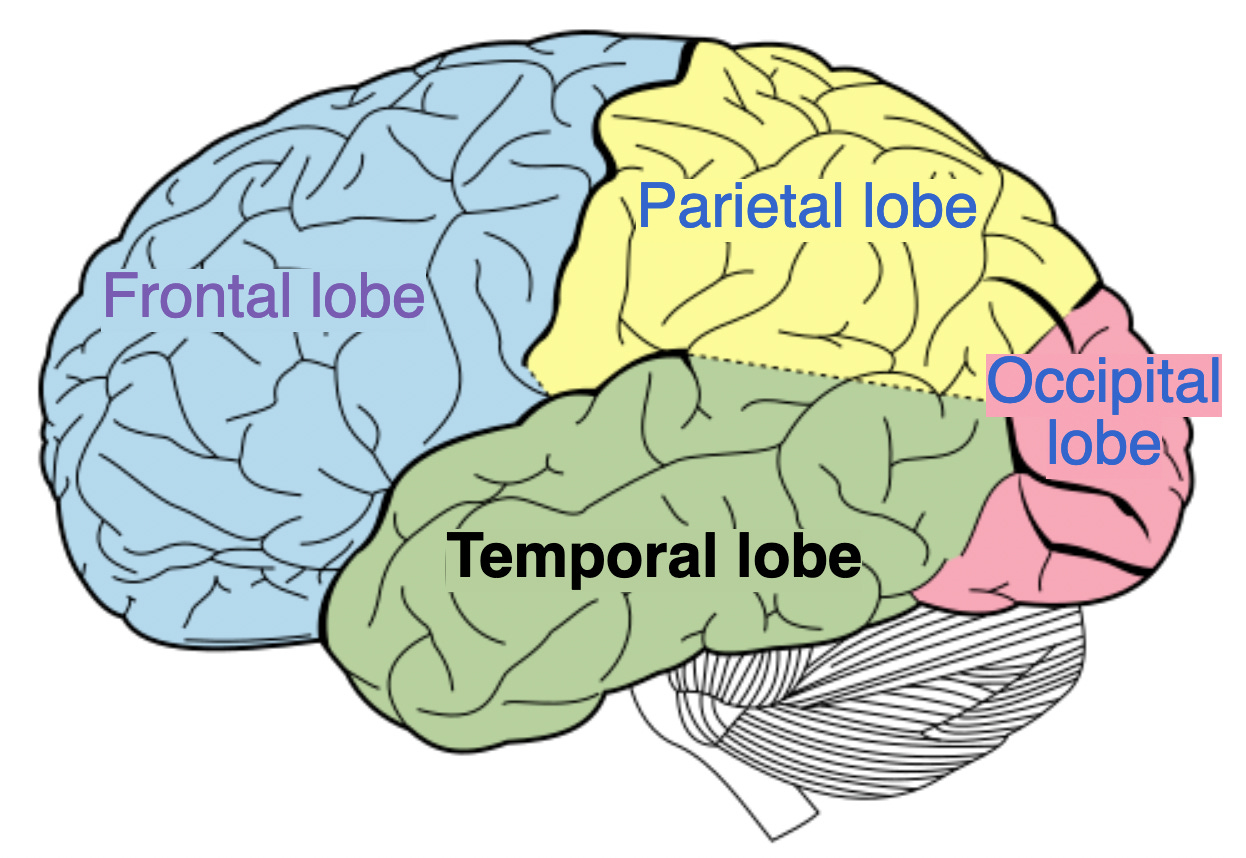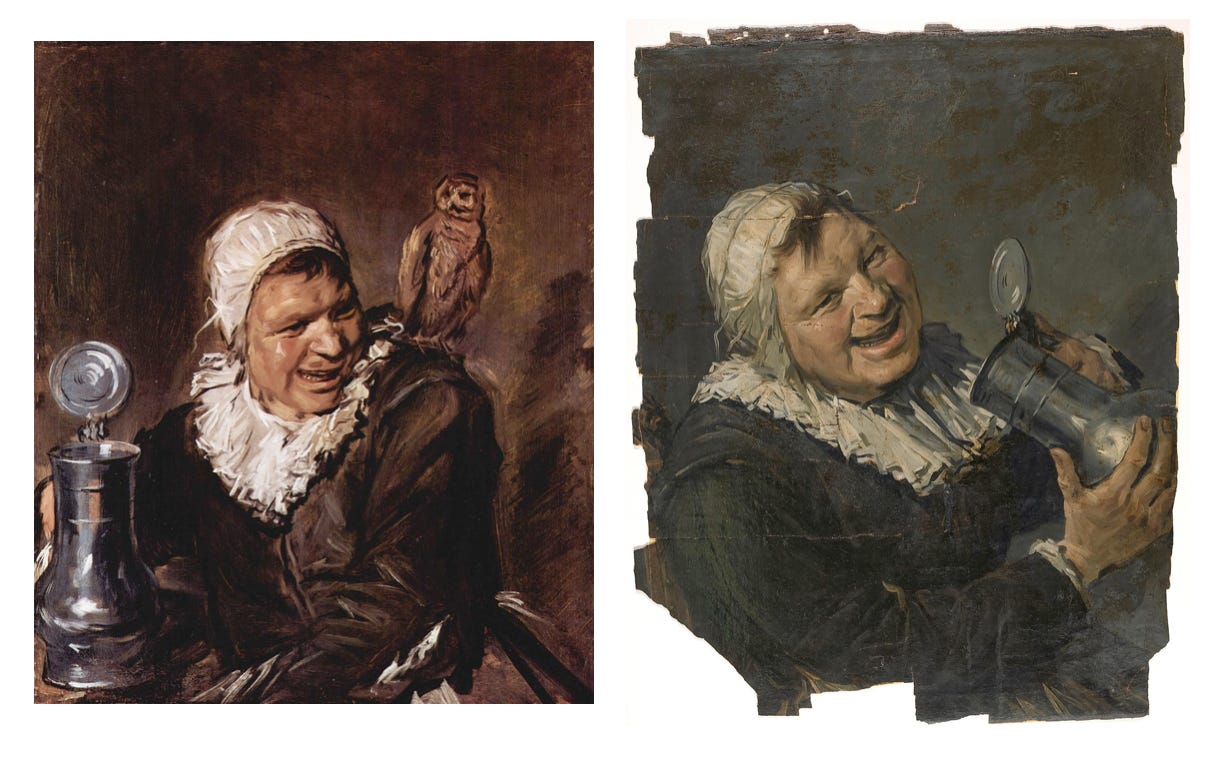Making Memories! And then figuring out which memory bucket they belong in
What are the types of memory? How did we figure them out?
You have different types of memory. It ain’t just one big memory ball.
They have names too; episodic memory, procedural memory, semantic memory. These are stored in different places in your brain.
Figuring that out took like, a long time, man.
I’m going to skip Plato’s “all learning is recollection” and a couple of thousand years of anamnesis and eternal return and launch right in with everyone’s favourite topic: Phrenology!
Phrenology was a scientific doctrine where specific parts of the brain were said produce complex states like “destructiveness”, “sublimity” or “alimentiveness” (alimentiveness means the desire to eat, or the instinct to find, food, and has consequently launched itself immediately into my top 10 words).

This was sometimes used in a racist way to say that certain ‘types’ of people had certain cranial capabilities. That has all been covered by better, more interesting writers elsewhere.
Anyway, in the bits of the scientific community that cared about evidence and checking assumptions, phrenology had been outmoded since the work of Pierre Flourens in the 1820s.
He found that if you removed specific chunks of animal brains, like the destructiveness bit right above the ear (see above), the animals kept destroying things, they were just slightly worse at it. Basically, you just lowered their stats on all of the 27 phrenological attributes, like a Witches’ curse spell in Dungeons & Dragons. I have played Dungeons and Dragons once and this happened to me and I fell down a hole and was unable to escape as my strength stat was too low. Four hours well spent.
Incidentally, there are, specifically, 27 phrenological attributes, at least in the original phrenological work of Franz Joseph Gall, who does not give his name to the gall-bladder (I checked).
Flourens, sitting at a desk piled high with animal brains, decided that this meant that the brain was equipotential, meaning that all of the regions could perform all of the functions. He wrote that “all perceptions, all volitions occupy the same seat in these [cerebral] organs; the faculty of perceiving, of conceiving, of willing merely constitutes thereby a faculty which is essentially one”.
Fastforward to the 1920s, and this had changed a bit. People knew that some brain functions were localised - particularly the interpretation of language (in Wernicke’s area) and the production of speech (in Broca’s area). But they still didn’t think that all of them were.
In fact, many people still assumed that when it came to complex functions, the brain was basically just a big seething ball of electricity where random parts of it would solve problems, like a big storm cloud spitting out lightning at random.
In the 1920s, Karl Lashley made some rats run around a maze and gradually removed bits of their cerebral cortex. What do you think he found? If you take out more of a rat’s brain, does it survive Maze Runner better than a rat with less of its brain removed? Make your predictions now!
That’s right! He found that the more of the rats brain you removed, the worse they did. Incidentally, I wish I had chunks of my brain removed before sitting through Maze Runner.
And, uh, maybe more interestingly, he found that there wasn’t really much of a correlation between which bit of rat brain you removed and how badly the rats did. So he wrote this: “It is certain that the maze habit, when formed, is not localized in any single area of the cerebrum [the cerebral cortex] and that its performance is somehow conditioned by the quantity of tissue which is intact,” which is a complicated and boring way of saying my thing about the storm clouds and the lightning.
As the 20th century wore on, people realised that mazes actually require lots of different cognitive skills, like paying exorbitant entry fees and giving way to irritating children, and consequently are not just a glorified memory test.
This is the reason that now, when doctors test how far Alzheimer’s patients memories have degraded, they don’t make them run through a massive labyrinth. Usually, doctors just show them a card with like, hippos and zebras on it and see if they remember what they are. I have watched many of these types of tests. They are much less interesting than forcing Alzheimer’s patients to run through a massive labyrinth, and as soon as I become Health Secretary I will make some serious changes.
Basically, mazes are not great for testing memory specifically.
In the 1940s, Wilder Penfield had been treating focal epilepsy, where seizures occur in specific parts of the cortex. The easiest way to do this was, and still is, to remove epileptic tissue while keeping the important bits of the brain intact. This is probably much harder than it sounds.
Brain surgeons don’t use general anaesthetic. This is because they are all sadistic psychopaths who seek to torture people the brain has no pain receptors. Brain surgeons like Wilder Penfield are usually good people who use a small local anaesthetic.
This all meant that Penfield’s patients could talk to him while undergoing surgery. He would also stimulate parts of their brain with weak electrical current, and noticed that if he stimulated the temporal lobes, and only the temporal lobes, a small number of patients had experiences: “It sounded like a voice saying words, but it was so faint that I couldn’t get it.” Or, “I am seeing a picture of a dog and cat … the dog is chasing the cat.” Penfield thought these were small fragments of memory, produced by his weak electrical current.
Other scientists didn’t think this. One minor thing that people undergoing surgery for epilepsy all have in common is epilepsy - Penfield’s patients all had abnormal epileptic brains. This did not make them a representative sample group.
The mental experiences elicited under surgery also had a suspicious correlation with the mental experiences that occurred when epileptic patients suffered from seizures. Also, a lot of the reported experiences had fantastical elements, famously not a great indicator that you are tapping into real memories.
Penfield’s main accomplishment (in the field of memory) was to inspire other scientists, like William Scoville, to investigate the temporal lobes as a source of memory.
Here is your temporal lobe, by the way (your brain may vary):
You have two of them, one in each hemisphere.
In 1935, a nine-year old Henry Molaison was hit by a bicycle.

He suffered a head injury that ultimately gave him epilepsy, and by the age of 27, he was pretty much incapacitated. William Scoville removed the inner surface of Henry Molaison’s (or H.M.) temporal lobes in both hemispheres, as well as the hippocampus.
The good news was that H.M. stopped having seizures. The bad news was that H.M. was never again able to convert any new memories into permanent ones. The other bit of good news, though not for H.M., was that he shed a lot of light on how memory works.
It turns out, even without the ability to make new long-term memories, you can still do a lot of things. He could hold conversations and remember numbers and images, just only for the space of a few minutes.
This is why we now think that short-term and long-term memory are fully separate. Hahaha, jk, there’s still a huge debate and experts on memory still have massive debates about the different storage systems of the brain. Nonetheless, it told us that short-term memory and long-term memory can be stored separately.
H.M. also retained old long-term memories that he had prior to the surgery. He just couldn’t acquire new information. As Brenda Milner, whose work with H.M. was critical to gaining new ground in the study of memory, puts it:
“He couldn’t acquire the slightest new piece of knowledge. He lives today chained to the past, in a sort of childlike world. You can say his personal history stopped with the operation.”
But Milner extracted two important pieces of information from her work with H.M.:
Memory is a distinct mental function from other mental functions, like perceptual or motor abilities.
Loss of the hippocampus, and other medial temporal lobe structures, stops you converting short-term memories into long-term ones.
Then Milner found that H.M. could learn things in the long-term! He just couldn’t learn them explicitly.
She got H.M. to trace the outline of a star in a mirror, and his skill at tracing improved each day. H.M. never remembered improving, and yet he inexorably got better.

People assumed that these were special motor memories, and they got lumped into a bin labelled ‘exceptions’ and everyone went back to what they were doing, like putting electrodes into sea slugs.
Then, from the 1960s to the 1980s, scientists discovered that various parts of the brain were inextricably linked with various types of memory. For instance, rabbits who learned a blink response to a specific stimulus could still do that response with a massive lesion to their hippocampus. Where was the response localised? To the cerebellum. The striatum was found to be responsible for habit learning.
Remember at the start when I mentioned we had a bunch of types of memory? We’re there now. The wait is over. There is still a lot of debate about how exactly to draw the lines between each of these types of memory, but we’re just going to rely on Larry Squire’s influential paper: Memory systems of the brain.
Here is an image which breaks down the different memory systems from this paper:
The first important takeaway is that Larry Squire is sadly not a graphic designer. The next is the breakdown, which I’ll explain now as best I can. Declarative memory is what we usually think of as our memories. The ability to remember the events of our lives, usually known as episodic memory, and facts, usually known as semantic memory, all fall under the heading of declarative memory.
Nondeclarative memory is where it gets interesting. Skills and habits are learned without conscious awareness, as where H.M. got better at drawing that star, or maybe when you briefly got better at the guitar before not playing it for six months and letting your skills atrophy.
Priming and perceptual learning is where you unconsciously see something. Maybe you’re on a farm, looking at a horse, and you also see a wheelbarrow. About 5-10% of the mind’s activity is conscious, so you don’t actually see the wheelbarrow. But you do see it. You follow?
You had no awareness of seeing the wheelbarrow, but your knowledge of it is improved by the encounter. If you see that wheelbarrow again, you will process it faster. I know this could sound a bit like declarative memory - but they are distinct systems.
Simple classical conditioning is when I ring a bell and then I tase you. If I do this five times, you start to think the bell is linked to the tasing. This is what Pavlov did to dogs, except he used food instead of a taser.
Nonassociative learning comes in two brands; Habituation & Sensitisation. When snails get into your kitchen, and you tap their shell, they retreat into it. If you do this five times, and you just keep gently tapping, the snails chill out a bit and stop retreating as much. That’s habituation.
When snails get into your kitchen, and you tap their shell and then you tase them with a snail taser, they retreat into their shell. If you do this five times, the snail will respond to the slightest tap with a full on defensive operation. Other stuff in the environment - noises, smells, tastes - will freak out the snail more easily. That’s sensitisation. Imagine habituation like lowering your guard, and sensitisation like raising it.
Those are the types of memory. Aren’t you glad you stayed with me? Now it gets better.
The memory systems don’t all work together to make you a superhuman. They actively override each other. This means that if you inhibit one system, you can actually activate another system, which can sit beneath.
For instance, if you set up rats in a maze where they have to turn left to get food, that left-turn becomes habitual. They will do that instinctually if put into a new maze. If you give them lidocaine injections (read: brain-area disabling drug) into the caudate nucleus, that left-turn instinct is abolished. But the rats also remember where the food is spatially, so they use that knowledge instead of just relying on the left-turn.
When humans are given a tough learning task, you often see activity in the medial temporal lobes (MTL), as if we are trying to memorise that task. But as we get better at the task, the activity transfers from the MTL to the striatum. Activity in both is negatively correlated, suggesting that they represent two different approaches to the same task.
Encouraging people to tap into those different processes could help people with amnesia. For instance, on pattern differentiation tasks, monkeys with temporal lobe lesions outperform humans with temporal lobe lesions, because the humans attempt to utilise a memorisation strategy, which relies on the MTL. They learn the patterns after a few trials, then forget them after a few minutes. The monkeys instead use a striatal pathway and learn the patterns over several hundred attempts.
This could even be useful for people with intact hippocampi, as most of you likely are, who want to learn things as habit. Framing tasks in different ways encourages the use of different pathways. There is thus a possibility that we can frame tasks in such a way that overcomes blockages to memory or skill formation. I’m planning on looking at the work done on the neural pathways involved in the more effective learning techniques, and seeing if there is a concrete difference in brain areas used between those and other techniques. But spoiler alert: I don’t think much work has been done on this.
So, attending to problems in different ways may offer different learning paths. Larry Squire suggests:
To achieve a two-choice discrimination task for humans that is acquired as a skill, and in the way that monkeys learn the pattern discrimination task, one might ask humans to learn to discriminate between the paintings of a master and the paintings of a talented forger.
As opposed to say, just rote-learning the paintings of the master and the paintings of the forger.
So here’s a bit of irrelevant fun before we look at more at framing learning in later posts. Which Malle Babbe is by Frans Hals? And which is by the 20th century’s most talented forger, Hans van Meegeren?
The same again - this time, Han van Meegeren versus Vermeer:
If you’re having no luck so far, here’s one last one to redeem yourself - Vermeer versus van Meegeren again. I’m surprised this isn’t already a browser game somewhere. Maybe it is, and I’ve missed it.
Here are three things I’ve been enjoying this week:
This banger.
The work of Martin Johnson Heade.








